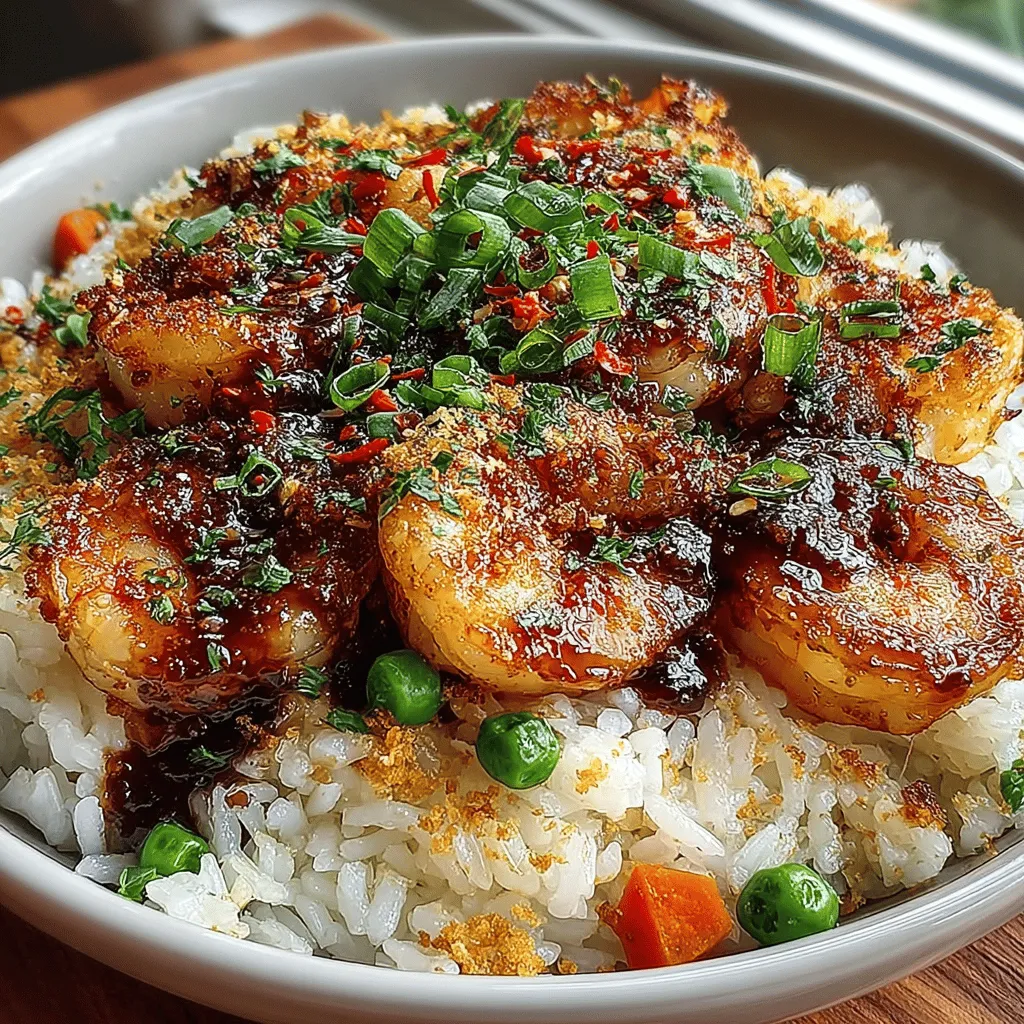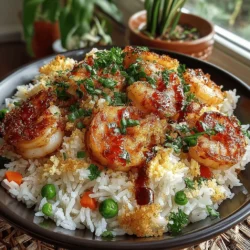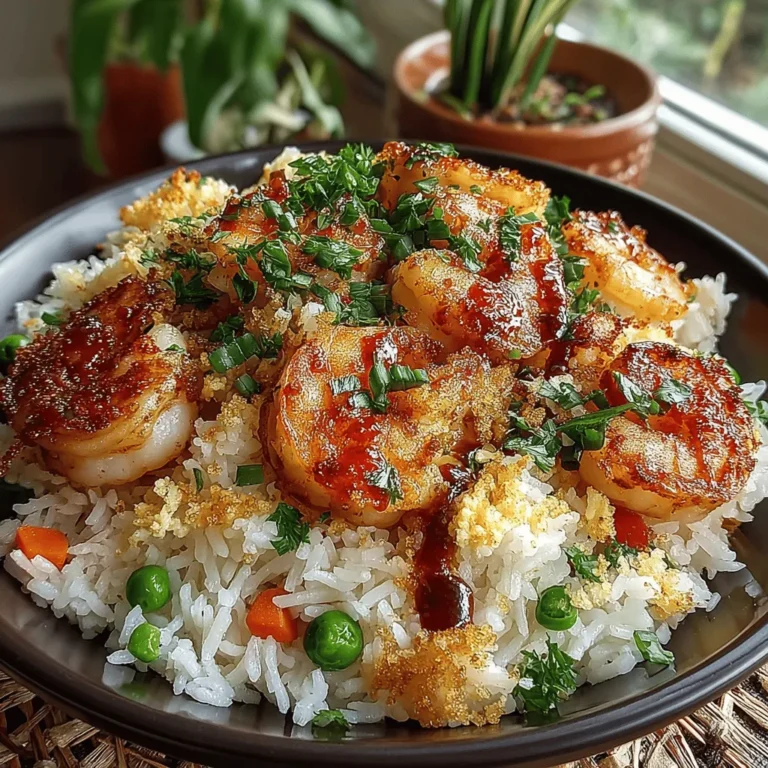Fried rice is a beloved dish that transcends borders and cultures, celebrated for its versatility and rich flavors. Originating in ancient China, fried rice has become a staple in many Asian cuisines, each region adding its unique twist. Whether it’s the classic Chinese Yangzhou fried rice or the spicy Thai version, this dish has evolved to fit various tastes and preferences around the world. Among the many variations, Shrimp Delight Fried Rice stands out as a delicious and easy recipe that combines succulent shrimp with vibrant vegetables and perfectly cooked rice.
Shrimp Delight Fried Rice is not only a treat for the palate but also a nutritious meal option. This recipe showcases how to create a flavorful dish using fresh ingredients and chilled rice, ensuring the perfect texture and taste. Using chilled rice is crucial; it keeps the grains separate and prevents the dish from becoming mushy. Fresh ingredients like shrimp, peas, and carrots contribute to both the flavor and nutritional profile, making this dish a balanced meal that can be enjoyed any time of the day.
Understanding Fried Rice
History of Fried Rice
Fried rice has a storied history that dates back to the Sui dynasty in China, around the 6th century. Initially, it was a practical way to use leftover rice, allowing for the incorporation of various ingredients available in the household. Over the centuries, fried rice has evolved, adapting to local flavors and ingredients, leading to its widespread popularity. Today, it is a common dish in numerous countries, each putting its unique spin on the traditional recipe.
Variations of Fried Rice
Fried rice variations are abundant, with each culture adding its unique flair.
– Chinese Fried Rice: Often features soy sauce, green onions, and a variety of proteins, including shrimp, chicken, and pork.
– Thai Fried Rice: Known for its fragrant jasmine rice and the addition of ingredients like lime and chili, providing a zesty kick.
– Japanese Fried Rice (Chahan): Typically includes a mix of vegetables and may incorporate ingredients like nori (seaweed) or a touch of mirin.
These variations not only reflect the culinary traditions of their respective countries but also highlight the adaptability of fried rice as a dish that can accommodate diverse tastes.
Nutritional Benefits
Incorporating shrimp and vegetables into fried rice adds significant nutritional value. Shrimp is an excellent source of protein, low in calories, and rich in essential nutrients such as selenium and vitamin B12. The addition of peas and carrots not only enhances the dish’s flavor but also provides vitamins A and C, along with dietary fiber. This combination makes Shrimp Delight Fried Rice a wholesome meal that satisfies both taste and health.
Ingredients Breakdown
Key Ingredients
1. Jasmine Rice: Known for its delicate floral aroma and slightly sticky texture, jasmine rice is ideal for fried rice. It holds up well during the cooking process, ensuring that each grain remains separate and flavorful.
2. Shrimp: Fresh shrimp is the star of this dish. When selecting shrimp, look for those that are firm, with a mild scent. Fresh, raw shrimp adds sweetness and a tender texture that enhances the overall dish.
3. Peas and Carrots: These vegetables not only add color and texture but also contribute nutrients. Frozen peas and carrots are convenient options, but fresh varieties can elevate the dish further.
4. Garlic and Green Onions: Essential for flavor, garlic brings a savory depth, while green onions add a fresh, crisp note. Together, they create a fragrant base for the fried rice.
5. Soy Sauce and Sesame Oil: Soy sauce provides umami and saltiness, while sesame oil adds a nutty richness. Choosing high-quality versions of these condiments can significantly enhance the flavor profile.
Optional Ingredients
Customization is part of what makes fried rice so appealing. Feel free to add optional ingredients such as bell peppers, corn, or even a splash of hot sauce for those who enjoy a spicy kick. This recipe is highly adaptable, allowing you to use what you have on hand or cater to personal preferences.
Preparation Techniques
Preparing Jasmine Rice
To achieve the perfect jasmine rice for fried rice, start by rinsing the rice under cold water until the water runs clear. This removes excess starch, preventing the rice from becoming gummy. Use a 1:1.5 rice-to-water ratio, bringing it to a boil, then reducing the heat to a simmer until the rice absorbs the water. Once cooked, spread it out on a baking sheet and allow it to cool. This cooling process is critical, as chilled rice fries better, resulting in a superior dish.
Chilling Rice for Frying
Chilling the rice is a vital step in preparing fried rice. Freshly cooked rice tends to be sticky and clumps together, which can lead to a mushy texture when fried. By cooling the rice in the refrigerator for at least a few hours or overnight, the grains firm up, making them less likely to stick together during cooking. This technique is essential for achieving that perfect fried rice texture.
Selecting and Cleaning Shrimp
When preparing shrimp, it’s important to choose high-quality, fresh seafood. If using frozen shrimp, ensure they are fully thawed before cooking. To clean the shrimp, remove the shells and devein them, which involves making a shallow cut along the back and removing the dark vein. This step not only makes the shrimp more appealing but also enhances the overall flavor of the dish.
Using Vegetables
While fresh vegetables are ideal, frozen peas and carrots are a convenient alternative that can save time in meal preparation. If you opt for frozen vegetables, add them directly from the freezer to the pan during cooking; this helps maintain their bright color and crispness.
With these foundational steps and insights into the ingredients and techniques, you are well on your way to mastering Shrimp Delight Fried Rice. In the next section, we will delve into the cooking process, providing a detailed walkthrough that ensures a delicious outcome every time. Stay tuned as we explore the techniques that will elevate your fried rice to new heights.

Importance of Heat Control When Frying Rice
When it comes to frying rice, heat control is crucial to avoid burning and achieving that perfect texture. Start by using a high heat setting once you add the rice to the pan, ensuring that it fries rather than steams. If the heat is too low, the rice will become mushy and lose its desired texture. Conversely, if the heat is too high, you risk burning the rice or unevenly cooking the ingredients. A good rule of thumb is to keep the heat at medium-high once the rice is introduced to the pan. This allows for the rice to get crispy edges while maintaining a fluffy interior.
It’s also essential to use a well-seasoned or non-stick wok or pan. These types of cookware help prevent sticking and allow for easy tossing of the ingredients. As the rice fries, keep it moving in the pan. Constant stirring not only helps to evenly distribute the heat but also prevents any parts from sticking and burning.
Tips for Achieving the Perfect Scramble for Eggs
Eggs are a vital component in fried rice, adding richness and a delightful texture. To achieve the perfect scramble, start by whisking your eggs thoroughly before adding them to the pan. This ensures a uniform texture and prevents clumping. When cooking the eggs, use medium heat and allow them to cook gently.
Cook the eggs in a separate section of the pan before mixing them with the rice. This method gives you more control over the doneness. Once the edges start to set, gently push the eggs around with a spatula, allowing the uncooked parts to flow to the edges. This technique creates soft, fluffy curds rather than overcooked, rubbery eggs. Aim for a creamy texture, and remember that the eggs will continue to cook slightly even after they have been removed from the heat.
Techniques for Combining Ingredients Without Overcooking the Rice
Combining ingredients in fried rice requires finesse to ensure that everything is well mixed without compromising the rice’s texture. After frying the rice, add your cooked shrimp and vegetables in small batches. This prevents overcrowding the pan and allows for even heat distribution.
Use a gentle folding technique with your spatula, lifting the rice from the bottom and incorporating the ingredients from the top. This method helps maintain the integrity of the rice grains while ensuring that each bite is packed with flavor. If you find that the rice is sticking together, a splash of water or additional oil can help break up clumps and facilitate the mixing process.
Flavor Development
Balancing flavors is key to making your Shrimp Delight Fried Rice truly delicious. The saltiness from the soy sauce, the richness from sesame oil, and the freshness of the vegetables should work harmoniously together. When adding soy sauce, start with a smaller amount and gradually increase it, tasting as you go. This process allows you to control the saltiness and ensures that it complements rather than overwhelms the dish.
Incorporating freshness is equally important. Adding vegetables such as peas, bell peppers, and green onions not only enhances the flavor but also adds crunch and color to the dish. Don’t forget to taste and adjust your seasonings throughout the cooking process; this will help you achieve the desired depth of flavor.
Garnishes play a significant role in enhancing both flavor and presentation. A sprinkle of chopped green onions, a handful of cilantro, or a dash of sesame seeds can elevate your dish, adding visual appeal and an extra layer of taste. These final touches can make your fried rice look professional and inviting.
Serving Suggestions
Presentation can make a significant difference in the enjoyment of your Shrimp Delight Fried Rice. Consider serving it in a large bowl or on a platter, garnished with additional herbs or sliced green onions for a pop of color. You can also create a bed of lettuce or garnish with lime wedges for an appealing contrast.
When it comes to side dishes, consider pairing your fried rice with a light cucumber salad or spring rolls. These options provide a refreshing bite that complements the richness of the fried rice. For drinks, a chilled jasmine tea or a light, fruity white wine can enhance the meal perfectly, balancing the flavors of the dish.
Culinary Variations and Customizations
One of the beauties of Shrimp Delight Fried Rice is its versatility. If you’re looking to make the dish vegetarian or vegan, simply substitute shrimp with tofu or tempeh. Both options absorb flavors well and add a satisfying protein element. You can also use a variety of vegetables based on what’s in season or available, such as broccoli, snap peas, or carrots.
For those who prefer different proteins, chicken, beef, or even crab can be excellent substitutes for shrimp. Just be sure to adjust cooking times accordingly to ensure that your protein is fully cooked.
If you crave some heat, consider creating a spicy version of your fried rice. Incorporate sriracha, chili paste, or freshly chopped chilies into the dish. You can also experiment with spices such as cayenne pepper or red pepper flakes to find the perfect level of heat for your palate.
Nutritional Analysis
Understanding the nutritional content of your Shrimp Delight Fried Rice can help you enjoy it as part of a balanced diet. Shrimp is a great source of lean protein, while vegetables contribute essential vitamins and minerals. Brown rice can be used as a healthier alternative to white rice, offering more fiber and nutrients.
The caloric breakdown per serving can vary, but a standard serving of shrimp fried rice typically ranges from 400 to 600 calories, depending on the ingredients used and portion size. For a healthier option, consider using low-sodium soy sauce to reduce overall sodium intake. Additionally, practicing portion control can help you enjoy this dish without overindulging.
Conclusion
In summary, Shrimp Delight Fried Rice is not only a delicious meal but also a versatile dish that can be customized to suit various dietary preferences. With its blend of flavors, textures, and colors, it’s a fantastic option for any occasion, whether it’s a weeknight dinner or a gathering with friends.
We encourage you to experiment with different ingredients and flavors in your home cooking. The joy of making and sharing homemade meals with loved ones is truly unparalleled. So gather your ingredients, embrace the cooking process, and enjoy the delightful results of your culinary efforts.


